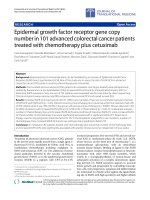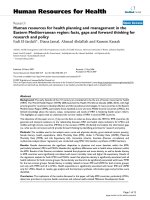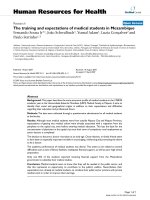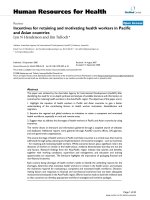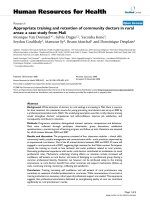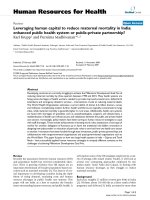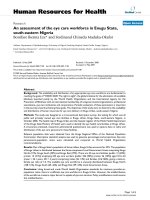Báo cáo sinh học: " Fibroblast growth factor 2 orchestrates angiogenic networking in non-GIST STS patients" potx
Bạn đang xem bản rút gọn của tài liệu. Xem và tải ngay bản đầy đủ của tài liệu tại đây (1005.45 KB, 8 trang )
RESEARCH Open Access
Fibroblast growth factor 2 orchestrates
angiogenic networking in non-GIST STS patients
Thomas K Kilvaer
1*
, Andrej Valkov
1,2
, Sveinung W Sorbye
1,2
, Eivind Smeland
4
, Roy M Bremnes
3,4
,
Lill-Tove Busund
1,2
and Tom Donnem
3,4
Abstract
Background: Non-gastrointestinal stromal tumor soft-tissue sarcomas (non-GIST STSs) constitute a heterogeneous
group of tumors with poor prognosis. Fibroblast growth factor 2 (FGF2) and fibroblast growth factor receptor-1
(FGFR-1), in close interplay with platelet-derived growth factor-B (PDGF-B) and vascular endothelial growth factor
receptor-3 (VEGFR-3), are strongly involved in angiogenesis. This study investigates the prognostic impact of FGF2
and FGFR-1 and explores the impact of their co-expression with PDGF-B and VEGFR-3 in widely resected tumors
from non-GIST STS patients.
Methods: Tumor samples from 108 non-GIST STS patients were obtained and tissue microarrays were constructed
for each specimen. Immunohistochemistry was used to evaluate the expressions of FGF-2, FGFR-1, PDGF-B and
VEGFR-3.
Results: In the multivariate analysis, high expression of FGF2 (P = 0.024, HR = 2.2, 95% CI 1.1-4.4) and the
co-expressions of FGF2 & PDGF-B (overall; P = 0.007, intermediate; P = 0.013, HR = 3.6, 95% CI = 1.3-9.7, high;
P = 0.002, HR = 6.0, 95% CI = 2.0-18.1) and FGF2 & VEGFR-3 (overall; P = 0.050, intermediate; P = 0.058, HR = 2.0,
95% CI = 0.98-4.1, high; P = 0.028, HR = 2.6, 95% CI = 1.1-6.0) were significant independent prognostic indicators
of poor disease-specific survival.
Conclusion: FGF2, alone or in co-expression with PDGF-B and VEGFR-3, is a significant independent negative
prognosticator in widely resected non-GIST STS patients.
Introduction
Soft-tissue sarcomas (STSs) constitute a group of
tumors of mesenchymal lineage, comprising over 50 his-
tological entities [1]. T he incidence is low and the leth-
ality is high. With an estimate of 10 000 new cases and
nearly 4 000 related death s in the US in 2010 , STSs
remain one of the most aggressive types of cancer [2].
Current STS treatment comprises wide resection of
the primary tumor with supplementary radiotherapy to
those with high-grade lesions [3-5]. Since the use of
chemotherapy is a challenge in adult STS, due to con-
troversial efficacy [6], good prognostic and predictive
indicators are highly warranted to help select patients
for different types of chemotherapy treatments.
Fibroblast growth factors (FGFs) are heparin binding
growth factors and as of today there are 18 FGFs and 4
fibroblast growt h factor receptors (FGFRs) identified in
humans [7]. The most extensive research in this field
has been done on FGF2 (also known as basic fibroblast
growth factor; bFGF), a growth factor primarily binding
FGFR-1 [7]. FGF2 is a known promoter of angiogenesis
and lymphangiogenesis [8]. Further, FGF2 stimulates
cell growth and migration, but also, in some cases,
differentiation [8].
Compared to healthy controls, plasma FGF2 l evels, in
sarco ma patients, is reported to be elevated. In contrast,
low plasma FGF2 levels prior to surgery have been asso-
ciated with an increased risk of recurrence [9-12]. FGF2
presence has also been confirmed in studies of sarcoma
cell-lines [13].
FGF2 has been implicated as a player in different
angiogen ic and lymphangiogenic pathways [8]. Nissen et
al. reported a reciprocal relationship between FGF2 and
* Correspondence:
1
Institute of Medical Biology, University of Tromso, PB 9037, Tromso, Norway
Full list of author information is available at the end of the article
Kilvaer et al. Journal of Translational Medicine 2011, 9:104
/>© 2011 Kilvaer et al; licensee BioMed Central Ltd. This is an Open Access article distributed under the terms of the Creative Commons
Attribution License (htt p://creativecommons.org/licenses/by/2.0), which permits unrestricted us e, distribution, and reprod uction in
any medium, provided the original work is properly cited.
platelet-derived growth factor-B (PDGF-B) through their
corresponding receptors [14]. Kubo et al. found FGF2
induced lymphangiogenesis to be blocked by vascular
endothelial growth factor receptor-3 (VEGFR-3) inhibi-
tors [15]. Further, in a study on human umbilical cord
endothelial cells grown in the presence of VEGF-A,
Welti et al. found FGF2 to rescue angiogenesis in pre-
sence of the VEGFR inhibitor Sunitinib
®
[16].
We have previously reported on the prognostic impact
of the PDGFs and VEGFs and their receptors in this
cohort of non-GIST STS patients [17,18]. The aim of
this study was to invest igate the prognostic impact of
FGF2 and FGFR-1 expression, and their co-expressions
with PDGF-B and VEGFR-3, in widely r esected non-
GIST STS patients.
Patients and methods
Patients and Clinical Samples
Primary tumor tissue from anonymized patients diag-
nosed with non-GIST STS at the University Hospital of
North-Norway and the Hospitals of Arkhangelsk county,
Russia, from 1973 through 2006, were collected. In total
496 patients were registered from the hospital databases.
Of these, 388 patients were excluded from the study
because of: missing clinical data (n = 86), inadequate
paraffin-embedded fixed tissue blocks (n = 161) or non-
wide resection margins (n = 141). Thus 108 patients
with complete medical records, adequate paraffin-
embedded tissue blocks and wide resection margins
were eligible.
This report includes follow-up data as of September
2009. The median follow-up was 68.4 (range 0.5-391.7)
months. Complete demographic an d clinical data were
collected retrospectively. Formalin-fixed and paraffin-
embedded tumor specimens were obtained from the
archives of the Departments of Pathology at the Univer-
sity Hospital of North-Norway and the Hospitals of
Arkhangelsk C ounty, Russia. The tumors were graded
according to the French Fédération Nationale des cen-
tres de Lutte Contre le Cancer (FNCLCC) system and
histologically subtyped according to the World Health
Organization guidelines [1,19]. Wide resection margins
were defined as wide local resection with free micro-
scopic margins or amputation of the affected limb or
organ.
Microarray construction
All sarcomas were histologically reviewed by two trained
pathologists (S. Sorbye and A. Valkov) and the most
representative areas of tumor cells (neoplastic mesench-
ymal cells) we re carefully selected and marked on the
hematoxylin and eosin (H/E) slide and sampled fo r the
tissue microarray (TMA) blocks. The TMAs were
assembled using a tissue-arraying instrument (Beecher
Instruments, Silver Springs, MD). The Detailed metho-
dology has been previously reported [20,21]. Briefly, we
used a 0.6 mm diameter stylet, and the study specimens
were routinely sampled with four replicate core samples
from d iffe rent areas of neoplastic tissue. Nor mal tissue
from the patients was used as staining control.
To include all core samples, 12 TMA blocks were
constructed. Multiple 5-μm sections were cut with a
Micron microtome (HM355S) and stained by specific
antibodies for immunohistochemistry (IHC) analysis.
Immunohistochemistry
The applied antibodies were subjected to in-house
vali dation by the manufacturer for IHC analysis on par-
affin-embedded material. The antibodies used in the
study were FGF2 (rabbit polyclonal; AB1458; Chemicon ;
1:200) and FGFR-1 (rabbit polyclonal; sc-121; Santa
Cruz; 1:50). T he IHC procedures for PDGF-B and
VEGFR-3 have been previously described [17,18].
Sections were deparaffinized with xylene and rehy-
drated with ethanol. Antigen retrieval was performed by
placing the specimen in 0.01 M citrate buffer at pH 6.0
and exposed to microwave heating of 10 minut es at 250
W (FGF2) or heated by pressure boiler of 2 minutes
(FGFR-1). The DAKO EnVision + System-HRP (DAB)
kit was used as endogen peroxidase blocking. As nega-
tive staining controls, the primary antibodies were
replaced with the primary antibody diluent. Primary
antibodies were incubated for 30 minutes (FGF2) or 60
minutes (FGFR-1) in roo m temp erat ure. The kit DAKO
EnVision + System-HRP (DAB) was used to visualize
the antigens. This was followed b y application of liquid
diaminobenzidine and substrate-chromogen, yielding a
brown reaction product at the site of the target antigen.
Finally, all slid es were counter-stained with hematoxylin
to visualize the nuclei. For each antibody, included
negative staining controls, all T MA staining were per-
formed in a single experiment.
Scoring of immunohistochemistry
The ARIOL imaging system (Genetix, San Jose, CA) was
used to scan the slides of antibody staining o f the
TMAs. The slides were loaded in the automated slide
loader (Applied Imaging SL 50) an d the specimens were
scanned at low resolution (1.25×) and high resolution
(20×) using the Olympus BX 61 microscope with an
automated platform (Prior). Representative and viable
tissue sections were scored manually on the computer
screen semi-quant itatively for cytoplasmic staining. The
dom inant stai ning intensity was scored as: 0 = negative;
1 = weak; 2 = i ntermediate; 3 = strong. All samples
were anonymized and independently scored by two
trained pathologists (A. Valkov and S. Sorbye). When
assessingavariableforagivencore,theobserverswere
Kilvaer et al. Journal of Translational Medicine 2011, 9:104
/>Page 2 of 8
blinded to the scores of the other variables and to out-
come. Mean score for duplicate cores from each indivi-
dual was calculated separately.
High expression in tumor cells was defined as score ≥
2(FGF2andFGFR-1)(Figure1).Thepreviouslypub-
lished cut-off values for PDGF-B and VEGFR-3 (≥ 1.5)
were used to estimate the co-expressions with FGF2 and
FGFR-1 [17,18].
Statistical Methods
All statistical analyses were done using the statistical
pack age SPSS (Chicago, IL), version 16. The IHC scores
from each observer were compared for interobserver
reliability by use of a two-way random effect model with
absolute agreement definition. The intraclass correlation
coefficient (reliability coefficient) was obtained from
these results . The Chi-square test and Fisher s Exact test
were used to examine the association between molecular
marker expression and v arious clinicopathological
parameters.Univariateanalysesweredoneusingthe
Kaplan-Meie r method, and statistical significance
between survival curves was assessed by the log-rank
test. Disease-specific survival (DSS) was determined
from the date o f diagnosis to the time of cancer related
death. To assess the independent value of different
pretreatment variables on survival, in the presence of
other variables, multivariate analyses were carried out
using the Cox proportional hazards model. Only vari-
ables of significant value from the univariate analyses
were entered into the C ox regress ion analysis. Probabil-
ity for stepwise entry and removal was set at . 05 and
.10, respectively. The significance level used for all
statistical tests was P < 0.05.
Ethical clearance
The National Data Inspection Board and The Regional
Committee for Research Ethics approved the study.
Results
Clinopathological Variables
The clinopathological variables are summarized in
Table 1. The media n age was 57 (range 0-86) years, 56%
were female, 73 patients were Norwegian and 35 Russian.
The Non-GIST STSs comprised 108 tumors including
angiosarcoma (n = 5), fibrosarcoma (n = 8), leiomyosar-
coma (n = 34), liposarcoma (n = 13), pleomorphic sar-
coma (n = 29), neurofibrosarcoma/malignant peripheral
nerve sheath tumor (MPNST, n = 5), rhabdomyosarcoma
(n = 6), synovial sarcoma (n = 6) and unspecified
sarcoma (n = 2). The tumor origins were distributed as
follows: 43% extremities, 19% trunk, 7 % retroperitoneal,
4% head/neck and 28% visceral. In addi tion to surgical
resection , 6 patients received both radio -and chemoth er-
apy, 23 patients received chemotherapy alone and 15
patients received radiotherapy alone.
Interobserver variability
Interobserver scoring agreement was tested for FGF2
and F GFR-1. The intraclass correlation co efficients were
0.80 for FGF2 (P < 0.001) and 0.93 for FGFR-1 (P <
0.001), indicating good reproducibility between the
investigating pathologists.
Expression of FGF2/FGFR-1 and their Correlations
FGF2/FGFR-1 expression was localized in the cytoplasm
of tumor cells.
FGF2 did not correlate with the clinical variables while
low FGFR-1 expression correlated with small tumor size
(low expression; < 50 mm 44%, 50-100 mm 34%, > 100
mm 22%, P = 0.005).
Univariate Analyses
Table 1 summarizes the prognostic impact of the clino-
pathological variables. Patient nationality (P < 0.001),
malignancy grade (P < 0.001), tumor depth (P = 0.009)
and metastasis at diagnosis (P < 0.001) were prognostic
indicators of DSS.
The influence on DSS by FGF2 and FGFR-1 are given
in Tabl e 2 and Figure 2 panels A and B. High
Figure 1 IHC analysis of TMA of non-gastrointestinal stromal
tumor soft-tissue sarcoma representing different scores for
tumor cell FGF2 and FGFR-1. (A) Tumor cell FGF2 low score in
Fibrosarcoma; (B) Tumor cell FGF2 high score in undifferentiated
pleomorphic sarcoma; (C) Tumor cell FGFR-1 low score in
undifferentiated pleomorphic sarcoma; (D) Tumor cell FGFR-1 high
score in undifferentiated pleomorphic sarcoma. Abbreviations: FGF,
fibroblast growth factor; FGFR, fibroblast growth factor receptor; IHC,
immunohistochemistry; TMA, tissue microarray.
Kilvaer et al. Journal of Translational Medicine 2011, 9:104
/>Page 3 of 8
Table 1 Prognostic clinicopathological variables as predictors for disease-specific survival in patients with completely
resected non-gastrointestinal stromal tumor soft-tissue sarcomas (univariate analyses, log rank test; multivariate
analysis, Cox regression analysis)
Univariate analyses Multivariate analysis
Characteristics Patients
(n)
Patients
(%)
Median
survival
(months)
5-Year
survival
(%)
P HR 95% CI P
Age
≤ 20 years 7 7 NR 57 0.960
21-60 years 55 51 NR 64
> 60 years 46 43 NR 60
Gender
Male 47 44 NR 74 0.054
Female 61 56 127 53
Patient nationality
Norwegian 73 68 NR 73 < 0.001 1.000
Russian 35 32 22 38 2.777 1.457-5.292 0.002
Histological entity
Pleomorphic sarcoma 29 27 54 50 0.127
Leiomyosarcoma 34 32 68 53
Liposarcoma 13 12 NR 92
Fibrosarcoma 8 7 NR 88
Angiosarcoma 5 5 NR 60
Rhabdomyosarcoma 6 6 NR 67
MPNST 5 5 NR 80
Synovial sarcoma 6 6 59 80
Sarcoma NOS 2 2 NR 100
Tumor localization
Extremities 46 43 NR 66 0.735
Trunk 21 19 NR 60
Retroperitoneum 7 7 NR 71
Head/Neck 4 4 NR 75
Visceral 30 28 63 53
Tumor size
≤ 5 cm 40 37 NR 75 0.262
5-10 cm 46 43 NR 53
>10cm 20 18 NR 60
Missing 2 2
Malignancy grade 0.015*
1 32 30 NR 90 < 0.001 1.000
2 36 33 NR 61 3.808 1.084-13.380 0.037
3 40 37 32 39 5.937 1.721-20.481 0.005
Tumor depth
Superficial 12 11 ** ** 0.009 ** ** **
Deep 96 89 57
Metastasis at diagnosis
No 97 90 218 66 < 0.001 1.000
Yes 11 10 8 27 4.689 2.004-10.972 < 0.001
Chemotherapy
No 79 73 NR 65 0.234
Yes 29 27 120 55
Radiotherapy
No 87 81 NR 63 0.375
Yes 21 19 NR 57
Abbreviations: NR, not reached; MPNST, malignant peripheral nerve sheath tumor; NOS, not otherwise specified; *, overall significance as a prognostic factor; **all
cases were censored.
Kilvaer et al. Journal of Translational Medicine 2011, 9:104
/>Page 4 of 8
expression of FGF 2 was significantly (P = 0.048) asso-
ciated with a poor prognosis.
Multivariate Cox Proportional Hazards Analysis
Table 1 and 2 summarizes the results of the multivariate
analysis of clinopathological variables and marker
expression, respectively. Russian nationality (P = 0.002),
high malignancy grade (P = 0.0 15), metastasis at diagno-
sis (P < 0.001) and high FGF2 expression (P = 0 .024,
HR = 2.203, 95% CI 1.11-4.38) were significant indepen-
dent negative indicators of DSS.
Co-expressions
In univariate analyses, the co-expressions of FGF2 &
PDGF-B (P = 0.011) and FGF2 & VEGFR-3 ( P = 0.042)
were significant p rognostic indicators of DSS (Table 2).
In the multivariate analyses, high expression of FGF2 &
PDGF-B was, when compared to low expression, a sig-
nificant independent prognostic indicator of poor DSS
(HR = 6.0, 95% CI = 1.966-18.132, P = 0.002). High
expression of FGF2 & VEGFR-3 (HR = 2.6, 95% CI =
1.106-6.038, P = 0.028) wa s also a significant indepen-
dent prognost icat or (Table 2, Figure 2 panels C and D).
Figure 3 shows proposed actions of expressed FGF2,
PDGF-B and VEGFRs in non-GIST STSs.
Discussion
In the study presented herein we have observed high
tumor expression of FGF2 and the co-expressions of
FGF2 & PDGF-B and FGF2 & VEGFR-3 to be signifi-
cant, independent and unfavorable prognostic indicators
of DSS in non-GIST STS patients with wi de resection
Table 2 Tumor expression of FGF2, FGFR-1 and the co-expressions of FGF2 & PDGF-B and FGF2 & VEGFR-3 and their
prediction for disease-specific survival in patients with completely resected non-gastrointestinal stromal tumor soft-
tissue sarcomas (univariate analyses, log rank test; multivariate analysis, Cox regression analysis)
Univariate analyses Multivariate analysis
Marker expression Patients
(n)
Patients
(%)
Median
survival
(months)
5-Year
survival
(%)
P HR 95% CI P
FGF2
Low 75 69 NR 68 0.048 1.000
High 30 28 54 50 2.203 1.108-4.379 0.024
Missing 3 3
FGFR-1
Low 78 72 NR 61 0.830
High 28 26 NR 62
Missing 2 2
FGF2 & PDGF-B 0.007*
Low 27 25 NR 81 0.011 1.000
Intermediate 52 48 NR 59 3.569 1.311-9.715 0.013
High 25 23 45 48 5.971 1.966-18.132 0.002
Missing 4 4
FGF2 & VEGFR-3 0.050*
Low 51 47 NR 70 0.042 1.000
Intermediate 35 32 120 56 1.999 0.978-4.087 0.058
High 16 15 45 46 2.584 1.106-6.038 0.028
Missing 6 6
FGFR-1 & PDGF-B
Low 26 24 NR 75 0.061
Intermediate 56 52 120 55
High 23 21 NR 58
Missing 3 3
FGFR-1 & VEGFR-3
Low 57 53 NR 66 0.344
Intermediate 29 27 120 59
High 18 17 63 52
Missing 4 4
Abbreviations: FGF, fibroblast growth factor; FGFR, fibroblast growth factor receptor; NR, not reached; PDGF, platelet-derived growth factor; VEGFR, vascular
endothelial growth factor receptor; *overall significance as prognostic factor.
Kilvaer et al. Journal of Translational Medicine 2011, 9:104
/>Page 5 of 8
margins. Few studies have investigated FGF2 and FGFR-
1 in STS and no previous studies have reported on the
co-expressions with PDGF-B and VEGFR-3. To our
knowledge this is the first e valuation of these pathways
in non-GIST STSs.
We have previously reported on the prognostic impact
ofPDGFsandVEGFsinthispatientcohort[17,18].In
the previous investigationswefoundtheprognostic
impact of these growth factors and their pathways to b e
dependent on wide resection margins. Without wide
resection margins, the prognosis is poor with only 30%
5-year survivors and angiogenic markers could not dis-
tinguish between prognostic groups.
Our results are, by large, consistent with previously
published data on FGF2 in STSs. Graeven et al. reported
that FGF2 levels i n serum of STS patients were elevated
in comparison to that of controls [12]. Yoon et al., using
microarray techniques, found FGF2 gene-expression to
be significantly higher i n STS patient tissue samples
compared to healthy controls [11]. We found high FGF2
expression in tumor to be a significant independent
negative prognostic marker in non-GIST STS patients
with wide resection margins.
There are seve ral ways in which FGF2 can promote
non-GIST STS development, as illustrated in Figure 3.
Endothelial cells treated with FGF2 in vitro an d in vivo
form tubes, prolifer ate and are induced to migr ate [8].
Further, FGF2 has also been associated with extracellular
matrix remodeling, pivotal in angiogenesis/lymphangio-
genesis, through increased release and expression of
matrix metallo-proteinases and urokinase-like plasmino-
gen activator [8]. In addition, FGF2 has recently been
shown to rescue PDGF-B transfected cells undergoing
Imatinib
®
induced apoptosis [22] and to sustain the
angiogenic profile of human umbilical cord cells grown
with VEGF-A in the presence of the VEGFR inhibit or
Sunitinib
®
[16]. Angiogenesis is one of the hallmarks of
cancer and a daptation of an angiogenic profile is one of
the deciding steps in carcinogenesis [ 23]. These latter
results indicate that the FG F pathway contributes to the
redundancy observed when targeting angiogenesis in can-
cer (Figure 3b). In a ddition, FGF2 could function as a
growth factor on the tumor cells in a paracrine/autocrine
fashion, activating intracellular pathways and ultimately
leading cells to proliferate, avoid apoptosis or become
insensitive to antigrowth signals (Figure 3a) [8,24].
Survival (months)
120100806040200
Disease-specific survival
1.0
0.8
0.6
0.4
0.2
0.0
FGF2
Low, n = 75
High, n = 30
P = 0.048
A
Survival (months)
120100806040200
Disease-specific survival
1.0
0.8
0.6
0.4
0.2
0.0
FGFR-1
Low, n = 78
High, n = 28
P = 0.830
B
Survival (months)
120100806040200
Disease-specific survival
1.0
0.8
0.6
0.4
0.2
0.0
FGF2 & PDGF-B
Low, n = 27
High, n = 25
Intermediate, n = 52
P = 0.011
C
Survival (months)
120100806040200
Disease-specific survival
1.0
0.8
0.6
0.4
0.2
0.0
FGF2 & VEGFR-3
Low, n = 51
High, n = 16
Intermediate, n = 35
P = 0.042
D
Figure 2 Disease-specific survival curves for (A) FGF2; (B) FGFR-
1; (C) FGF2 & PDGF-B; (D) FGF2 & VEGFR-3. Abbreviations: FGF,
fibroblast growth factor; FGFR, fibroblast growth factor receptor;
PDGF, platelet-derived growth factor; VEGFR, vascular endothelial
growth factor receptor.
(B)
Sprouting ECs
Pericytes
ECs
VSMCs
PDGF-B
PDGF-B
FGF2
FGF2
(A)
Cancer cells
FGFR
VEGFR
PDFGR
Antiapoptosis
Increased cell
cycling
Gene
transcription
PDGF-B
PDGF-B
FGF2
FGF2
Activation of
several
intracellular
pathways
Insensitivity to
anti growth
signals
MMPs
uPa
ECM degradetion/remodelling
Paracrine/autocrine
Figure 3 Proposed mechanisms of stimulation of growth,
angiogenesis and motility in non-gastrointestinal stroma
tumor soft-tissue sarcomas expressing FGF2, PDGF-B and
VEGFR-3. (A) Paracrin and/or autocrin stimulation of cancer cells
leading to activation of intracellular pathways and subsequently
survival benefits; (B) FGF2 stimulating angiogenesis through
recruitment of endothelial cells and increasing release of MMPs and
uPa leading to ECM degradation and remodeling thus enabling
tumor cell expansion and motility, PDGF-B recruiting VSMCs and
stimulating pericyte coverage of newly formed vessle; Abbreviations:
ECM, extracellular matrix; FGF, fibroblast growth factor; FGFR,
fibroblast growth factor receptor; PDGF, platelet-derived growth
factor; PDGFR, platelet-derived growth factor receptor; MMP, matrix-
metallo proteinase; uPa, urokinase-like plasminogen activator; VEGF,
vascular endothelial growth factor; VEGFR, vascular endothelial
growth factor receptor.
Kilvaer et al. Journal of Translational Medicine 2011, 9:104
/>Page 6 of 8
PDGF-B is an important stabilizer of blood-vessels,
working as a chemotactic and proliferative agent on vas-
cular smooth muscle cells (VSMCs) and pericytes
[25-27]. Nissen et al. investigated the possibility of inter-
actions between the FGF2 and PDGF-B signaling path-
ways and found FGF2 and PDGF-B to synergistically
induce neovascularizat ion in murine fibrosarcomas [14].
In our c ohort, patients who expressed high intensity
staining of PDGF-B an d FGF2 had HR’ sof3.9or2.2
[18], respectively, in comparison to those expressing low
intensity staining. Examining the co-expressio n of FGF2
& PDGF-B revealed a HR of 6.0 for the high-high
expression group ( Table 2), indicating an additive or
possiblyasynergeticeffectofthesepathwaysinnon-
GIST STSs.
VEGFR-3 is classically associated with lymphangiogen-
esis, but has recently been linked to angiogenesis
[28,29]. Using the mouse corneal assay, Kubo et al.
found FGF2 induced angiogenesis to be blocked by
administration of VEGFR-3 inhibitors, indicating an
interaction between these pathways [15]. Previously, we
found non-GIST STS patients with wide resection mar-
gins express ing high intensity VEGFR-3 staining to have
a HR of 2.0 compared to those with low intensity stain-
ing [17]. For the co-expression of FGF2 & VEGFR-3 we
found a HR of 2.6 in the high-high expression group,
indicating a modest additive effect between these path-
ways in non-GIST STSs.
FGF2, PDGF-B and VEGFR-3 exp ression leads to acti-
vation of several different intracellular pathways includ-
ing PI3K, MEKK, SEK, PLCg and others. Further studies
to investigate the relative involvement of these pathways
in sarcoma angiogenesis development would be of great
interest. Players in these pathways could prove to be tar-
gets for novel therapeutic approaches both together with
cytokine binding antibodies a nd receptor blockers and
alone.
We have previously found FGF2 and the co-expres-
sionsofFGF2&PDGF-BandFGF2&VEGFR-3tobe
poor independent prognosticators in an unselected large
non-small cell lung cancer cohort [30]. The finding o f
similar results in cancers derived from different embryo-
nic cell-layers ma y indicate that tumor vasculogenesis as
a whole, or at least for certain mechanisms, are univer-
sal processes.
Conclusion
The angiogenic and lymphangiogenic systems have
redundant and synergetic properties making it difficult
to target these pathway s with chemotherapy a lone.
Nevertheless, we observed t hat high express ion of FGF2
and the co-expressions of FGF2 & PDGF-B and FGF2 &
VEGFR-3 are significant independent negative prognos-
tic factors in widely r esected non-GIST STS patients.
These results suggest that the angiogenic properties of
sarcomas are versatile and complex, hence multitargeted
antiangiogenic treatment could prove an interesting
approach in non-GIST STSs.
Funding
This study was funded by the Northern Norway Health
Authority, The Norwegian Childhood Cancer Network,
The Norwegian Sarcoma Group, The Norwegian Cancer
Society and The University of Tromso.
List of abbreviations
bFGF: basic fibroblast growth factor; CI: confidence interval; DSS: disease-
specific survival; FGF: fibroblast growth factor; FGFR: fibroblast growth factor
receptor; FNCLCC: French Féd ération Nationale des centres de Lutte Contre
le Cancer; H/E: hematoxylin/eosin; HR: hazard rate; IHC:
immunohistochemistry; MMP: matrix metallo proteinase; MPNST: malignant
peripheral nerve sheath tumor; Non-GIST STS: non-gastrointestinal stromal
tumor soft tissue sarcoma; NOS: not otherwise specified; NR: not reached;
PDGF: platelet-derived growth factor; PDGFR: platelet-derived growth factor
receptor; STS: soft tissue sarcoma; VEGF: vascular endothelial growth factor;
VEGFR: vascular endothelial growth factor receptor; TMA: tissue microarray;
uPa: urokinase-like plasminogen activator.
Aknowlegdements
Thanks to Frode Skjold for coupling of databases, Magnus L. Persson for
making the TMA blocks and Helge Stalsberg for helping to collect clinical
information.
Author details
1
Institute of Medical Biology, University of Tromso, PB 9037, Tromso, Norway.
2
Department of Clinical Pathology, University Hospital of North Norway, PB
9038, Tromso, Norway.
3
Institute of Clinical Medicine , University of Tromso,
PB 9037, Tromso, Norway.
4
Department of Oncology, University Hospital of
North Norway, PB 9038, Tromso, Norway.
Authors’ contributions
All authors participated in the study design, result interpretation and in the
writing. TK, AV, SS and ES contributed in making the clinical and
demographic database. TK, SS and AV scored the cores. TK and TD did the
statistical analysis. TK drafted the manuscript. All authors read and approved
the final manuscript.
Competing interests
The authors declare that they have no competing interests.
Received: 23 February 2011 Accepted: 6 July 2011
Published: 6 July 2011
References
1. Fletcher CDM, Unni KK, Mertens F: Pathology and genetics of tumours of
soft tissue and bone. Lyon: IARC Press; 2002.
2. Jemal A, Siegel R, Xu J, Ward E: Cancer statistics, 2010. CA Cancer J Clin
2010, 60(5):277-300.
3. Dickinson IC, Whitwell DJ, Battistuta D, Thompson B, Strobel N, Duggal A,
Steadman P: Surgical margin and its influence on survival in soft tissue
sarcoma. ANZ J Surg 2006, 76(3):104-109.
4. Mendenhall WM, Indelicato DJ, Scarborough MT, Zlotecki RA, Gibbs CP,
Mendenhall NP, Mendenhall CM, Enneking WF: The management of adult
soft tissue sarcomas. Am J Clin Oncol 2009, 32(4):436-442.
5. Kaushal A, Citrin D: The role of radiation therapy in the management of
sarcomas. Surg Clin North Am 2008, 88(3):629-646.
6. Thornton K: Chemotherapeutic management of soft tissue sarcoma. Surg
Clin North Am 2008, 88(3):647-660.
7. Beenken A, Mohammadi M: The FGF family: biology, pathophysiology
and therapy. Nat Rev Drug Discov 2009, 8(3):235-253.
Kilvaer et al. Journal of Translational Medicine 2011, 9:104
/>Page 7 of 8
8. Presta M, Dell’Era P, Mitola S, Moroni E, Ronca R, Rusnati M: Fibroblast
growth factor/fibroblast growth factor receptor system in angiogenesis.
Cytokine Growth Factor Rev 2005, 16(2):159-178.
9. Ruka W, Rutkowski P, Kaminska J, Rysinska A, Steffen J: Alterations of
routine blood tests in adult patients with soft tissue sarcomas:
relationships to cytokine serum levels and prognostic significance. Ann
Oncol 2001, 12(10):1423-1432.
10. Yoon SS, Segal NH, Olshen AB, Brennan MF, Singer S: Circulating
angiogenic factor levels correlate with extent of disease and risk of
recurrence in patients with soft tissue sarcoma. Ann Oncol 2004,
15(8):1261-1266.
11. Yoon SS, Segal NH, Park PJ, Detwiller KY, Fernando NT, Ryeom SW,
Brennan MF, Singer S: Angiogenic profile of soft tissue sarcomas based
on analysis of circulating factors and microarray gene expression. J Surg
Res 2006, 135(2):282-290.
12. Graeven U, Andre N, Achilles E, Zornig C, Schmiegel W: Serum levels of
vascular endothelial growth factor and basic fibroblast growth factor in
patients with soft-tissue sarcoma. J Cancer Res Clin Oncol 1999,
125(10):577-581.
13. Hu M, Nicolson GL, Trent JC, Yu D, Zhang L, Lang A, Killary A, Ellis LM,
Bucana CD, Pollock RE: Characterization of 11 human sarcoma cell strains:
evaluation of cytogenetics, tumorigenicity, metastasis, and production of
angiogenic factors. Cancer 2002, 95(7):1569-1576.
14. Nissen LJ, Cao R, Hedlund EM, Wang Z, Zhao X, Wetterskog D, Funa K,
Brakenhielm E, Cao Y: Angiogenic factors FGF2 and PDGF-BB
synergistically promote murine tumor neovascularization and metastasis.
J Clin Invest 2007, 117(10):2766-2777.
15. Kubo H, Cao R, Brakenhielm E, Makinen T, Cao Y, Alitalo K: Blockade of
vascular endothelial growth factor receptor-3 signaling inhibits
fibroblast growth factor-2-induced lymphangiogenesis in mouse cornea.
Proc Natl Acad Sci USA 2002, 99(13):8868-8873.
16. Welti JC, Gourlaouen M, Powles T, Kudahetti SC, Wilson P, Berney DM,
Reynolds AR: Fibroblast growth factor 2 regulates endothelial cell
sensitivity to sunitinib. Oncogene 2010.
17. Kilvaer TK, Valkov A, Sorbye S, Smeland E, Bremnes RM, Busund LT,
Donnem T: Profiling of VEGFs and VEGFRs as Prognostic Factors in Soft
Tissue Sarcoma: VEGFR-3 Is an Independent Predictor of Poor Prognosis.
PLoS One 2010, 5(12):e15368.
18. Kilvaer TK, Valkov A, Sorbye SW, Donnem T, Smeland E, Bremnes RM,
Busund LT: Platelet-Derived Growth Factors in Non-GIST Soft-Tissue
Sarcomas Identify a Subgroup of Patients with Wide Resection Margins
and Poor Disease-Specific Survival. Sarcoma 2010, 2010(2010):10
19. Guillou L, Coindre JM, Bonichon F, Nguyen BB, Terrier P, Collin F, Vilain MO,
Mandard AM, Le Doussal V, Leroux A, Jacquemier J, Duplay H, Sastre-
Garau X, Costa J: Comparative study of the National Cancer Institute and
French Federation of Cancer Centers Sarcoma Group grading systems in
a population of 410 adult patients with soft tissue sarcoma. J Clin Oncol
1997, 15(1):350-362.
20. Donnem T, Al-Saad S, Al-Shibli K, Delghandi MP, Persson M, Nilsen MN,
Busund LT, Bremnes RM: Inverse prognostic impact of angiogenic marker
expression in tumor cells versus stromal cells in non small cell lung
cancer. Clin Cancer Res 2007,
13(22 Pt 1):6649-6657.
21. Bremnes RM, Veve R, Gabrielson E, Hirsch FR, Baron A, Bemis L,
Gemmill RM, Drabkin HA, Franklin WA: High-throughput tissue microarray
analysis used to evaluate biology and prognostic significance of the E-
cadherin pathway in non-small-cell lung cancer. J Clin Oncol 2002,
20(10):2417-2428.
22. Ohshima M, Yamaguchi Y, Kappert K, Micke P, Otsuka K: bFGF rescues
imatinib/STI571-induced apoptosis of sis-NIH3T3 fibroblasts. Biochem
Biophys Res Commun 2009, 381(2):165-170.
23. Hanahan D, Weinberg RA: The hallmarks of cancer. Cell 2000, 100(1):57-70.
24. Dailey L, Ambrosetti D, Mansukhani A, Basilico C: Mechanisms underlying
differential responses to FGF signaling. Cytokine Growth Factor Rev 2005,
16(2):233-247.
25. Lindblom P, Gerhardt H, Liebner S, Abramsson A, Enge M, Hellstrom M,
Backstrom G, Fredriksson S, Landegren U, Nystrom HC, Bergstrom G,
Dejana E, Ostman A, Lindahl P, Betsholtz C: Endothelial PDGF-B retention
is required for proper investment of pericytes in the microvessel wall.
Genes Dev 2003, 17(15):1835-1840.
26. Abramsson A, Lindblom P, Betsholtz C: Endothelial and nonendothelial
sources of PDGF-B regulate pericyte recruitment and influence vascular
pattern formation in tumors. J Clin Invest 2003, 112(8):1142-1151.
27. Betsholtz C: Insight into the physiological functions of PDGF through
genetic studies in mice. Cytokine Growth Factor Rev 2004, 15(4):215-228.
28. Tammela T, Zarkada G, Wallgard E, Murtomaki A, Suchting S, Wirzenius M,
Waltari M, Hellstrom M, Schomber T, Peltonen R, Freitas C, Duarte A,
Isoniemi H, Laakkonen P, Christofori G, Yla-Herttuala S, Shibuya M,
Pytowski B, Eichmann A, Betsholtz C, Alitalo K: Blocking VEGFR-3
suppresses angiogenic sprouting and vascular network formation. Nature
2008, 454(7204):656-660.
29. Tammela T, Enholm B, Alitalo K, Paavonen K: The biology of vascular
endothelial growth factors. Cardiovasc Res 2005, 65(3):550-563.
30. Donnem T, Al-Shibli K, Al-Saad S, Busund LT, Bremnes RM: Prognostic
impact of fibroblast growth factor 2 in non-small cell lung cancer:
coexpression with VEGFR-3 and PDGF-B predicts poor survival. J Thorac
Oncol 2009, 4(5):578-585.
doi:10.1186/1479-5876-9-104
Cite this article as: Kilvaer et al.: Fibroblast growth factor 2 orchestrates
angiogenic networking in non-GIST STS patients. Journal of Translational
Medicine 2011 9:104.
Submit your next manuscript to BioMed Central
and take full advantage of:
• Convenient online submission
• Thorough peer review
• No space constraints or color figure charges
• Immediate publication on acceptance
• Inclusion in PubMed, CAS, Scopus and Google Scholar
• Research which is freely available for redistribution
Submit your manuscript at
www.biomedcentral.com/submit
Kilvaer et al. Journal of Translational Medicine 2011, 9:104
/>Page 8 of 8
